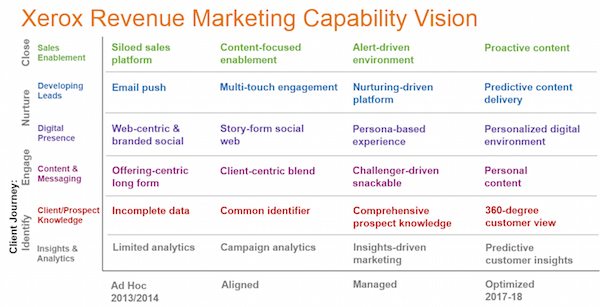If you want an example of how a marketing technologist can rise to an executive leadership role in a billion dollar company, you need not look any further than today’s guest for our marketing technologist interview series: Brad Terrell.
Brad is VP & General Manager of the Digital Media business unit at Netezza — a firm recently acquired by IBM for $1.7 billion. He is responsible for maximizing the value Netezza delivers to digital media firms such as AOL, CBS Interactive, eHarmony, Intuit, Merkle, and Nielsen, powering their large-scale data analysis initiatives with Netezza’s data warehouse applications.
Brad also writes about the intersection of media and technology on his blog, Data Drives Media.
Brad Terrell, VP & General Manager, Digital Media, Netezza
At Netezza, you help companies adopt some pretty sophisticated analytics technology. Does this technology incrementally improve existing marketing approaches, or is this an entirely different kind of marketing?
An entirely different kind of marketing. Netezza’s offering is essentially a massively parallel supercomputer optimized for data analysis — a relational database instantiated in hardware that enables marketers to analyze petabytes of data about people and their behaviors much more quickly and simply than was previously possible. This creates opportunities for innovative new approaches to marketing that dramatically increase both the reach and targeting precision of marketing campaigns.
For example, 40-year-old marketing powerhouse Acxiom is transforming the next generation of its popular InfoBase and PersonicX consumer insight offerings using Netezza to acquire data from over 10 times as many sources as its competitors and enable near real-time data refreshes on over 8 billion records containing over 2,000 unique elements per US household. As a result, Acxiom is able to differentiate its offerings from the competition by providing new classes of consumer insights to their clients that create entirely new kinds of marketing opportunities for them.
AppNexus, one of the hottest ad technology startups in NYC, provides another great example. Netezza enables the AppNexus real-time bidding (RTB) platform to serve over 5.5 billion highly targeted display advertising impressions each day in which advertisers analyze the value of each impression in real time using conversion data (hundreds of data points on a per-impression basis) in order to determine the optimal bid for each impression used to reach specific users in real time. And Netezza’s simplicity of deployment and operation allowed AppNexus to launch their offering ahead of schedule with a 92% reduction in operating costs.
Technologies like Netezza seem like they would require a lot of collaboration between marketing and IT. How do your best customers make that work? Are there certain kinds of individuals who really shine in these projects?
Data warehouses have historically been among the most complex of technologies. The Netezza appliance changed that — it is remarkably simply to deploy and operate. As a result, marketers can now analyze petabytes of data in a system typically maintained by less than one full time employee. This reduces the burden on IT significantly and often eases alignment challenges between IT and marketing.
Our best customers make collaboration between marketing and IT work in part through:
- Effective organizational design that aligns incentives across marketing and IT while placing decision power with those holding the most expertise and responsibility for project success.
- Instilling a culture of innovation and accountability.
But most importantly, our best customers hire “T-shaped people” that have deep expertise in at least one discipline, but also have broad skills and interests that enable them to work with a wide range of people across functional disciplines. Your excellent post on 8 things every marketing technologist should know offers specific guidance on how this idea applies to being a successful marketing technologist. The people that I see shine on marketing technology projects combine “T-shaped” characteristics with the ability to simply get things done.
“Our best customers hire ‘T-shaped people’ that have deep expertise in at least one discipline, but also have broad skills and interests.”
How are attitudes around technology changing in marketing management and the executive suite?
Technology is increasingly considered an important source of competitive advantage in marketing management and the executive suite. Marketers and senior execs want access to their own personal “rocket scientists” — people that can apply technology and data analysis to the art of marketing. The best rocket scientists — those that can understand and speak the languages of both technology and marketing — are moving out of the back office into significant leadership roles for their firms.
“Marketers and senior execs want access to their own personal ‘rocket scientists’ — people that can apply technology and data analysis to the art of marketing.”
In addition to this evolving attitude regarding the value of technology to marketers, the role of technology itself is evolving. Every marketing organization climbs a maturity curve over time with respect to their ability to leverage increasingly sophisticated classes of technology and data analysis to create competitive advantage. For example, simple reporting and ad hoc analysis lead to predictive analysis, and ultimately to machine learning and optimization techniques that automate decision-making on behalf of marketers. The uniform truth I see is that the firms that climb this curve the fastest are the ones that win.
If you could give 30 seconds of wisdom on marketing technology to the CMO of a Fortune 500 company, what would you say?
Don’t underestimate the power of technology to move the needle on the marketing metrics that matter most — customer acquisition and retention.
Marketing technology is evolving at a dramatic pace. For example, our ability to predict relevant messaging for specific audiences has improved considerably in the past few years, in part because modern data analysis platforms now allow segmentation and matching algorithms to consider much more data, and do it much more quickly than was previously possible. The result is that even the old algorithms can now achieve dramatically better results, and new classes of marketing algorithms that were previously infeasible are now possible.
To cite just a few examples, I’ve seen 300% to 2,000% conversion rate improvements at AOL Advertising, 25% conversion rate increases with 33% lower CPA at WPP’s Media Innovation Group, 50%+ increases in campaign lift at MediaMath, and over 20% revenue increases at Epsilon — all specifically attributed to their investments in state-of-the-art technology. Treating technology as a strategic asset pays off for CMO’s.
“Treating technology as a strategic asset pays off for CMO’s.”
The title of your own blog is “Data Drives Media” — what do you mean by that?
It’s a reference to the massive industry transformation that is underway as the proliferation of new digital devices fragments consumer attention, thus creating new challenges and opportunities for marketers seeking a share of that attention.
All of these new media devices (computers, smartphones, gaming systems, set-top boxes, etc.) create a “digital exhaust” of data as consumers interact with them, and this data creates compelling opportunities for marketers that invest in analyzing it. I enjoy exploring these topics through my blog.
You have a computer science degree from Rice and an MBA from MIT. How has that combination of engineering and business/marketing helped you?
Going to great schools has certainly opened doors for me. I once had a mentor tell me, “Most people are really good at one thing. If you can be really good at two things, that will give you a leg up.” My engineering background taught me how to manage through complexity and get things done, and also amplified my love for building things (initially products, then teams, and ultimately companies).
“Most people are really good at one thing. If you can be really good at two things, that will give you a leg up.”
But it takes more than great technology to create great business success. Early in my career as an engineer, I helped develop the core technology for Spyglass Mosaic, the world’s first commercial web browser. Spyglass Mosaic was licensed by Microsoft to form the basis of the Internet Explorer web browser. It was great technology, but when the “browser wars” with Netscape led Microsoft to bundle Internet Explorer with Windows and give it away for free, much of the license revenue to Spyglass dried up. It was a painful lesson on market strategy, channel structure, and bad contracts.
But the most important lesson I learned from that experience was that creating value only leads to success if you are also able to capture that value in the form of revenue. It motivated me to move to the “revenue side” of business and I’ve been there ever since. Combining my early engineering experience with my subsequent sales and marketing focus lets me execute effectively on the most important of all business-building tasks: linking the unique capabilities of a firm to appropriate markets in ways that maximize the value a firm can create and capture.
Any advice you would give to up-and-coming marketing technologists?
Focus all of your efforts on generating revenue for your firm. If you are not able to quantify your contributions in terms of revenue, then you are either in the wrong role or in the wrong firm.
Work at a firm where customer insight is considered a source of competitive advantage. This is most likely to be true at firms that either sell to very many customers or reach their customers through complex sales channels.
Great marketing technologists can quantify the costs and benefits of nearly every aspect of their firm’s strategies for customer acquisition and retention. But don’t lose sight of the fact that business (and marketing) is fundamentally about people. Pick up the phone and get to know your customers — the insights gained from those personal relationships will shed new light on your data.
“Great marketing technologists can quantify the costs and benefits of near every aspect of their firm’s strategies.”
Thanks, Brad!



